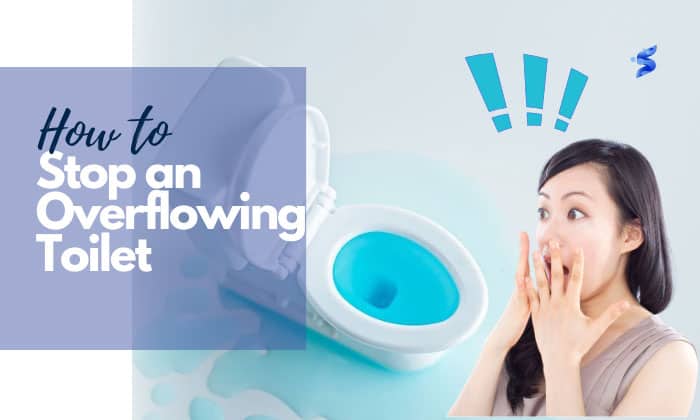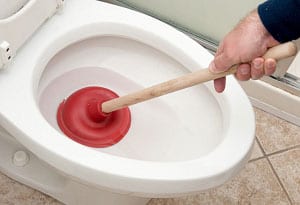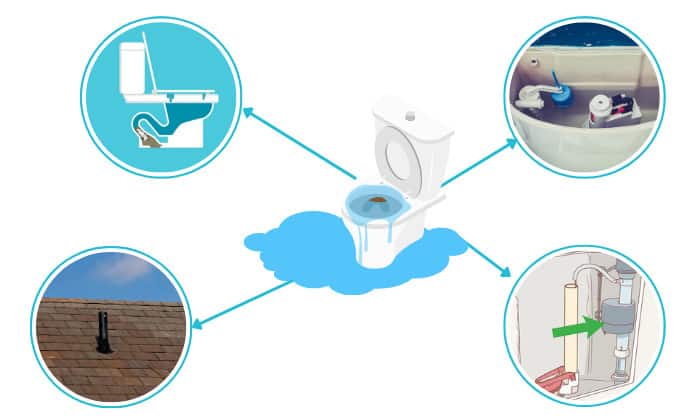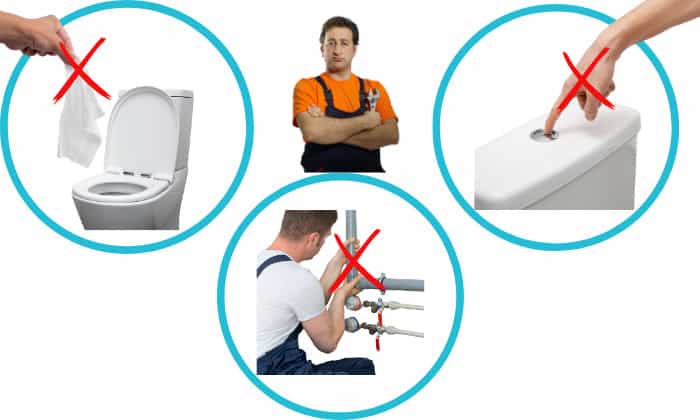Dealing with an overflowing toilet can be a messy and unpleasant experience that no one wants to encounter. However, it’s a common problem that can happen to anyone!
In this article, we’ll share some practical and easy-to-follow tips on how to stop an overflowing toilet quickly and effectively.
From turning off the water supply to using a plunger, we’ll provide instructions to help you handle this frustrating situation and keep a toilet from overflowing like a pro.
Table of Contents
Step-by-Step to Stop an Overflowing Toilet
An overflowing toilet is a common problem that is pretty easy to recognize; for example, you can see the toilet water rising when flushing with a strange, gurgling sound.
It is likely that there are clogs or blockages down the toilet pipe, which cause the water to go up instead of down. Or there might be some issues with the flapper.
Luckily, you can handle the issue yourself with the right tools and knowledge!
To fix an overflowing toilet, you can follow these steps:
1. Stop flushing the toilet
First, you should not keep flushing the toilet. Adding more water to the bowl will exacerbate the problem, as more liquid may spill out of the toilet and dirty your floor. You must solve the underlying problem of why your toilet keeps overflowing after flush first.
2. Close the water supply
To stop toilet water from rising, turn off the shut-off valve on the wall near the toilet.
You may also take the toilet tank’s lid off, find the flapper, and check if it is not closed properly or is broken. Press down on the flapper to stop toilet from flooding.
If that does not work, try to lift the fill valve or the float to stop toilet from filling. Or you can try another way by taking out the refill tube from the overflow valve.
3. Use a plunger
Using a toilet plunger is a standard way to deal with toilet clogs. Put on rubber gloves and prepare a plunger to unclog a toilet that’s overflowing. You can remove a little water to prevent it from splashing on the floor when you do the next step.
Next, insert the plunger into the toilet and make sure that it seals to the toilet’s base. The plunger cup should have a flap to provide the best suction, and you should push the tool down for fifteen seconds or so.
When you’re done, turn on the water supply and flush to check if the issue is solved. If there is still a toilet overflowing plunger not working, you might want to try using a drain snake.
4. Use a drain snake
When clogged heavily, your toilet may require the use of a drain snake. First, you might want to insert the drain snake into the toilet’s hole and push it as far as you can so that it stops moving, which means it has reached the clogged areas.
Next, hold the drain snake and turn it clockwise to break down the clog.
The last step is to pull out the drain snake and see whether the culprit that clogs your toilet is trapped at the snake’s end. On its way out, the drain snake might carry toilet paper with poop and other waste, so prepare a trash bag next to you to dump them afterward.
Now you can flush the toilet to make sure it functions normally. So, without a plunger, you can totally use a drain snake to solve the issue!
5. Check for faulty flapper
If your toilet overflowing but not clogged, then the toilet flapper might be broken or loosely attached. Consider replacing it with a new one.
In case you do not know how to fix an overflowing toilet yourself, don’t hesitate to call a professional plumber and let them stop a toilet from overflowing with their tools and techniques.
What Causes Overflowing Toilets?
As we have said before, an overflowing toilet might be caused by clogs or a broken flapper, but it can also be because of other issues like a blocked vent pipe or a filler float that is set too high.
Getting professional help with the right tools and techniques can resolve toilet overflowing from tank due to these issues.
Ways to Unclog an Overflowing Toilet
Knowing what to do when a toilet overflows helps you be more flexible in this situation. After you turn off the water supply, you might want to check the flapper to see if it’s broken or not. Then, drain water from overflowing toilet, which might require you to prepare a bucket.
Next, you can either use a plunger to pump out the clogs, or a drain snake to pull out the items inside the toilet’s pipe. Further issues like a clogged vent pipe might require the help of a plumber.
Things You Should Not Do With an Overflowing Toilet
When the toilet won’t flush water rises, you might not know what to do. However, there are certain things you should avoid with an overflowing toilet, which you must keep in mind:
- As toilet water rises too high when flushed, do not flush many times!
- Do not put any chemicals or foreign objects, or tools and bulky materials into the toilet.
- Do not remove pipes and other things connected to the toilet’s water lines.
Conclusion
In conclusion, stopping an overflowing toilet may seem like a daunting task, but with the right techniques, you will handle it well. If you notice that your toilet randomly overflows when not in use, call the nearest plumber to diagnose the problem.
By following the suggested solutions in this article on how to stop an overflowing toilet, you can quickly and effectively stop and prevent any further damage to your bathroom or plumbing system.

I’m Paulk Webb, and I work as a writer for Saveourwaterrebates. I’m happy to put in the time and effort to conduct market research to identify the most pressing issues faced by households concerning their plumbing. Feel free to check out our guides to get the most informed recommendations for how to solve your problems.









